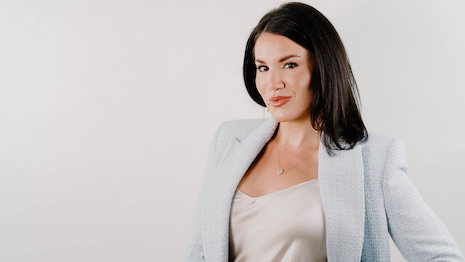By Olivia Steele
Fifteen years ago, I entered the halls of Trend Union, also known as Edelkoort Inc., in the heart of Paris, France, where my fascination with the emerging trends in the luxury sector, particularly sustainable fashion, first took root.
From that pivotal moment, my admiration for this evolving industry only deepened, with a keen eye on trailblazing companies like Positive Luxury, symbolized by the graceful butterfly, as they pioneered a new standard for sustainability.
Fast forward to the present day. The Wall Street Journal recently unveiled a compelling article on the excessive surplus of luxury goods, presenting a quandary for companies uncertain about their disposal.
As the industry grapples with excess inventory, new opportunities emerge for strategic partnerships between luxury brands and sustainability-focused counterparts.
Consciousness in context
Two decades ago, sustainability was a burgeoning concept in the fashion world. Today, it has evolved into a central tenet, with consumers actively seeking out environmentally conscious practices as a key discussion point.
The quest for sustainability has become a crucial factor in shaping brand image and consumer loyalty. Cue Stella McCartney’s new line!
To gain an expert's perspective on the matter, I spoke with Cassandra Kane, the founder and designer of We Are Sieme, a distinguished sustainable luxury leather handbag company, and Zerolab, a pioneering leather recycling center and sustainable design hub in Italy.
Ms. Kane highlights that luxury brands have ample opportunities to tackle this challenge through the integration of sustainable solutions, thereby reaping the benefits of industry leadership. Additionally, this presents remarkable prospects for smaller sustainable luxury brand designers.
One noteworthy approach is upcycling, a method that transforms discarded materials, creating products that surpass the original in value or quality. Collaborations with emerging sustainable brands offer a gorgeous avenue.
However, challenges surface on the manufacturing front, as items not initially designed for upcycling may pose complications. Yet, the benefits of upcycling far outweigh the associated costs, providing brands access to previously untapped markets and elevating emerging designers, a pivotal aspect reshaping the perception of luxury-level upcycling.
These collections transcend the notion of being "second hand"; rather, they represent an intentional and curated capsule crafted from the world's finest materials. When executed with precision and marketed as a distinctive release, the releases can be extremely beneficial.
Expanding on this, Ms. Kane emphasizes, "These special drops serve as incredible opportunities for sustainable designers and larger brands alike, acting as a test market to gauge the appetite for such unique offerings."
Covering new ground
Recognizing this shift in consumer sentiment, luxury brands are exploring innovative ways to address excess inventory without compromising their esteemed images.
Rather than resorting to traditional sales and discounts, companies are opting for collaborations with sustainability-focused brands. This paradigm shift presents a unique opportunity for both sectors to join forces and create a meaningful impact.
Projects between luxury and sustainability brands not only address the issue of excess inventory but also align with the growing demand for eco-friendly and socially responsible products. By leveraging each other's strengths, these partnerships have the potential to redefine industry standards and set a precedent for responsible business practices.
Such collaborations can take various forms, ranging from limited-edition capsule collections to exclusive co-branded products. Luxury brands, burdened with excess inventory, can use these channels to repurpose materials, reduce waste and contribute to the circular economy.
Simultaneously, sustainability-focused brands gain access to the exclusive world of luxury, widening their reach and influencing consumers who may not have traditionally considered sustainable options.
This approach not only addresses the immediate challenge of excess inventory but also positions both luxury and sustainability brands as leaders in responsible and forward-thinking business practices. The subsequent products become more than mere items for purchase; they embody a shared commitment to ethical consumption and environmental stewardship.
One-for-all approach
As consumers increasingly prioritize sustainability, this collaborative strategy emerges as a win-win for both sectors. Luxury brands maintain their exclusivity by avoiding conventional discounts, while sustainability brands gain access to a broader audience through the allure of luxury collaborations.
Together, they forge a path towards a more sustainable and responsible future for the fashion industry, setting an example that transcends the temporary trends of the runway and embraces enduring values of environmental consciousness and ethical business practices.
Leveraging my expertise, I guide the strategic fusion of luxury and sustainability, ensuring a seamless integration of shared values and unique design aesthetics. Through careful curation and hands-on coordination, we create an authentic and intentional collection that resonates with eco-conscious consumers, elevating the brands' presence in the world of sustainable luxury.
Olivia Steele is cofounder and president/CEO of Conversation Couture, Austin.
{"ct":"sU1fWe1FFFET3n1xMSBzjs0lphpADsf6f9M79KpWjvsa+z1ynE\/3p3uMxzxaG+tyIlgc3\/EjDYS01N6tbT9iNJUSZCMnJw9VXPqw2NFB57eCEqYyQUTCHi3Z0mUrlXqy5ubvyQcwrNFWZ+fL3MX\/dNqnHThWaDaY0vhzAZ41j1vMzj58Un64R2JvfAxQztx2HRyYW2lM0ZxprRBHyVN2z\/1hl29VED0wPU+Tf0PfJ2P4eQ237tqyniQ7CITzO6jlznGRk7StFiDzrtx1SLb1Bg2R9IDLIUeKVDggHJ2Kme3WpsDkMBshfxkSh\/u4RE55KNUXe7rvOGOX52IxcqAMQAQwJB\/bPw\/iN1JTwDQ7DboYC9bSRjcHxeNfdduFWDg135peuO+UG\/2EfqZ8Tp5HqdXbJ5q5yA\/32MWWnygNvsESKnibJJy5i3mfVO9fBwAnNx1T0EmTQhq00yQ8sJ6hhxXPfgkQjTaxOsIYV9Gj7rly\/9PoTz16BiYSVmtss6NAqBL\/CzMHpYl7pw9jgM1jiOy+rWE6toWnt0qUr62ij9aWA2mn213E+LD5TgSSbIEtcI0YooAtKQ+NEW1u7V11NtSend1tcUk0pp\/WnTxy3ozKkEfQg7w8ZzdDRYcNfPR\/BgIzvIO6E4Hjn1hwhuJo88Pv8pUH3QjNp86mKzoDQQ+4RiYqJ76nSyiKXhZbiXLXvhAJNQXVjsifTEnkOph1oEXSfThakXhrpcZ\/vW7ZhA0clAuq7OXADxOHbCc6HedV06nrbmKgiQr03J+qCrF9\/MyqjVy4FCj+1RkyJX9Bwr8uWZve+9UU6YnaRCfT2xIkkuttpQKHu03oJaIg2oXK64iNb+B7UdVjQETu4rxV\/1FRt4p\/k+DYnex8d51EULlWsKFRiUOi6UM5uTirCzdjZo9mwFqY7ImG2KoPPJLAklWdwCOpFgL76PX1fOqOhsHFJVADFa0hoUepRAbRv0gJD3iQVij5zLNHjVbKV1veQXjfAbmkVjbsBnEj1sUxlTRLbgjmKDpLAzGTHuKQmp4fAyVCGObBKMm8K6QcbL5XMeZIZBUdOE3B4Z2KHDykB2H\/gWhIVR4Y1KEqALHC\/8YhmFCFXjPlU1TB1IQbUKR2Au11mdXsfVquUVJinwiaNmWV+Rn+cpHk+iI04bbh2Ol30JZHv2VTI+1lPg+s6LgwGajwJg\/FAusFRQj0OD+TvaNtI1RhltRKp\/gE8kaq3SPLpay8On3FjhVviLLCWhB5SlRP6flvTbVrFXumkBqpF1eHaAbfXRP2O4fg5HNcEROr+E3OOcgnh4c88MgGu4ptregEpGxwfc\/8\/dsOj9DodL9\/K2fUBfhZc1H7ak2VRGkGLZFO77xWE3JaYe2Xu3mQEw5RM7Az+Wh5iZWkXYR5JMrRCanQTWxc5ARMi9MyhpFN190Mvqh73vN3uvPA+CtgXsvDX2j8hhgVzs7u7nUd\/m8Hu4pzPczzzwiXP9ocQF\/yoykjOmFTKvVVqOVhUurGXyoBCbhA26UtNza3GgQLdJzNgxVLXZEOqQbjr6IftsC0oXOwnCYxxll6h+9D30JSt697tuLEAV74Enz5M7989oQyOxzvjN7cuoLE8Cmd1rfYqNjoiFIwcbBEVBXFui7t7rv63ryMawr1DMWVCf+u\/1tsuLiBEbfauSEeolPhAiOdFIEdWACgKLSjy8aoNbiZkmwjNGDFeYZKJuYJ+7SRUjnTLNlTlx\/BYe+AsoMQXF4M8QePsNLinyq7KRELI6Q0YGYiIQ2CYq\/N51BUjyl9wBKHQT3Pw9M+7pBXj25Dn\/hml6IO2p6HDPaZLUA2+cuTZAoH24OaVsC8EFBPQIaDSHekfzcEnQ0ntXrfiMOrDL6WEjQbukRt1cnbzQXXweDNx9Y4\/atp0IacTzLD2lvezmtrtHvWvYdCin2l9BkE6Aj+mbGWMmYedhte37RRVI6PSh5Qem76V4iIRsEP55xZEIdBjzuzp4z6CXEhRV9vAhhFbN+y7bLNrJHIyNekD3Jn+mXYxq+fNQdmN2nUQdVo+fKFl8Th67fsELyeKCyX6lwPO4WqG9VOhZ7GqtyvVAubKU2iaisqaqrOz3eqxm+u2MNMFQ3m28Tlsn64VcjCXItvWANKfWQfGvU90LP3VT9Puk9a\/P+ftfPELC0FqFG6SQy3aPZOHMv50KmsxmKGAinNJVKZG2Wwn2y8mca8Aia7ri17o+h4sN\/FDzWS5MUi99J+laePE26EEaYEPbC+D7OzXC6Owor78O+AbWsKU8KZOqT7S0BdG4MWJ7fp6uCGMvyfWZzEwtiD5qMKpmuqXk5su9mcqsqlcrD7DxxBdxB8OCNMjX\/1Q4GOADSrVEyeLsnDPh1TuqqeHW8LfK04O6Lw7gBd4hVU4SYn7wyO9Yk3FAG5aNwoXTs8EOAALYo6N9pjCd3UovdR786CrVg9bMDw09cAzgey7vkPQlM0V4K3YOPkEKcMOLkCr5YEF+H6pPQFSV9RqGtEGR\/7W70WR2wR9bi+eNjf4DRY2Y2Gpn3z\/hmyDCTt8PzU+d9sijWUzKyzQDvSQkyJ6sOXb3ol2YPSP4bPryzjRGnZdESYv\/CdmrZyLri4aZae4Rgq\/esFc3mZXme2wBp+in5lXUTCIpouNmIjZwj4T3XJP42mCU\/CaDpQA3suNQY4dk8Ax0+ZYQWUdDzLcM4QqAHZpLDsioFWzOBQIDCr8wpGxCsePGGkVV7Ppjyo9f57896SSqwXRRPO558RXQMkJKeGI9xHi77mR+78uzBkgh4+RpwwL2rmYqh18hR8HZm81IUiSjtY7QcO5jniW85TLEuMDbojm0IUmZTBHZHjtpzli66WC37ynFnvLyTMojSGwJK9dIc2d39gSw9OGLyRkaKtp+tSHp+9Y2XfQ9BHRNewn\/oaTDvgFAuBTTGMOaQ+OC8KNR1xNXR1IsGl52KxgqCQdWvivXsYfRD1pu0hmK0u+8pgVt8JeQPThaegZJGaziJDY670VYguRX\/E0EFA4UMBKqMQCrGpfnuB8fnewHu+mCm9DwK50zSLrKJlk0GktU4okJH6FfFZoQXZCUM1e6Hlmg1Rc\/WzVFBYc98BEvgHmt6j4zwCHELvN6rxbthY1+kXvvp5nxdkHEocqLo3Ce+VqGIe\/utiCKSOT14lOzFd18eIEbTxvgnQi73WeqeJRLcbp5xrqIL\/qcdoKBq3EPu+9P2eAhMIaNhdx8JAbFUQhDFZSjmQ63DMkjEnfSjQsudtfOZK+2Xt+ro+TMOPaRYrX+JCCKbGOktExXzeCXyXq3z80XyySzsyDOLc0WkPZ34ie0rddewuFik5mHArfQ\/WJdXnDYybXwcXa+MwOiTmf3wnYZvd7n6mCriEXZu44LbrhNi5olKYBiEqfhnk2YoB9cgqc45UBBa4vqquDKoXSvmOMRQ5B3kHE8yhJmkaM\/pOpkQ+ZC2X6A4LX3WH58Te8qXAY5QQPPHe7cfbd+\/ALNfMt9JnWfEMuzOxdKRtuebc2AWsQqZMCYoNzIVvOf9elr0iO4XHVVAgQfP2kfE\/cpUF0icE6e2MX6xae8VVK1\/TEjN1R7bdEsu7Jqq++qyDWlhwfMq0WGbMyKl3RGfhYBNt84TTpfDakBOCfXXY+3bK9MqfZJz5WOWHMIE51XOZe7buCbY6uLA4z4YjrLnhiVx16MqIrlDpxTObIg\/RoR7zWvckmPeAXKZRNdOTa6sBAp+psKd0Ji+WTS9Cmh1XZMgZcxpahSLgpeq4i+t2M0PwsoG9WsUaQRJGgbCsLk3e+onawBcolU62zwd2XHsWEqj+0Wed63yoIpVh\/+zVUZg2aJZBw4By8C+4fTmprC\/aScbIRsSAyKw+7zRguUFUqmjI9Ize+AUdIVchU0YRo5ivhff99zn5DCaCtQtWbkFoG\/1PFp8gmlECNKhxAzodyBrk8K7xooSbIsndgbvR3UVPUynx+lad3VjF54brlBgAaoHt754rmu4sESGQjH2i5ysfr+RXCtJ2XNqJVtITU8rvs+XRMzhS9GW+UTiEGofQRsDTg0VHYtF0PM1snw+7T6F65rtFCIlHrlvqYBAMPK\/G9WkM686JJ0KSV1iyuNMq51IWZNjIJOCq44gVHszCG7FyjdF5N6SvNL\/wgJvvJIDM\/nBdM\/RrdYjSTGvFPxwLq9MxVsMQLGvAqVYJfApF4YvphxzajIan+FtEkm0qeldKfGAoJRoXCySE2kBLjpKPsjnrRxYQrBj9h3Ixjdr\/oFJdSwO8iJwYBJFvNGytSlPURsK8Ym3OjedHmXUWcmycdRe7T3BE6fTxxoDAEt9N8hpid+\/F3bu\/hNGsoylwSS3YMw7kt6MSywYXTFjfSJU2eMONv8Dr7oayl8F7COodcrFhcziUC7BOZNwu0W7DIaikdEx5gJunLNemEDWFLhbWFWOGEkBdEsZ+o4m821Ifej5rXY\/TxLSXyFGt8jNgccn3KmdlTKN+yy7R8eribP5HNpJOOEqkfMhBxRRLViSNd7+dHpcLl0Yd9x7Kqd0aK1+ONl2u65IkmLnTn3eBq3X7fb2TB7+RlP3hdRRMyB6yKZfE\/C+rxKsLbDR1v3G64F\/AiL8hJEggjREc6VNA3cPuUMNJ0Wjmzy1ypJULpeY9lkmsn94phe\/gIhx3fsXCz6lw+Q02GrKWmDmIuNTF63ypnfIRlOObJh7KMdCHsLjybGneYYKe\/bKrV1Tru4ypug5WHpyQ2Fuyx6N\/no7+1lIvpqqRcEzG4Az6igiGQGRQJmR\/G3fNL9fmj9DMiHKAcjWeYlSrbfMT3SYEx55c1IEtjrB7T4lpTGL3La\/BvsAqa1tEBYYFtW1u8NU68VMBcB1y0VT7B5mHa+4McR+R6yadmdHx8NK5TU5G8yCx4IdyMGQ5nkmilsEkI+UzSUFegvLN1FE34ZWaB06\/7o\/LxRHYfrGm0X0qlinuCA56y4752XktujMEZtJgTxzvQ134bQKomVbaAJVQXOTFBak5zAeNHMoPgfI2iE6C0BxQh9Bnby50n5gdBGqxG8LzaH9a\/s9JMTOcd4w\/ktnoT\/0BM9jjVVLMUsp+JzqSFcvIlVMKXa\/l0RGoqow3K\/QsATZLoKmeM6gON9X7XWHgIbl920VKlPHggfimR+UuspbaKBXw\/CAtzQgy2wYOx3YKWXeC\/GjtXbhRI8mD5dAjovTKYBpjqUiN+TATcteQXJlViVYfym+na7Svdv1UjQdY8cbthDgqsk8lOU+M6lJTILVZVCPQKP0\/xs5e\/W4V55KuL2QVRT8+NO2MeZrQGLuV00P8e70vYC3JUGhVcYTtYbuTocEOBZ12IFIjBNWY3ulAaWwkYvwrkw2UHZfBng\/ReOI5NX11q4WOGcRfSZpm3XepiilKRIgQFbKEGYSmRhHN\/SEaEq38IT5vQMpeoXYxOKvHph7llAEvTdOZ2weGbXKBxbgIlVPZ\/EW0X9XM0+SSPHPd8VHMDVqRiXNvByOn6LTzLM3GNidrqkRGuV+TG9XdICtUwDjonzxrcFee3sF2xCUm5nBWz\/awk1v2kgyfLASV\/3Alkt8I9dOkXzmiHe1lu8ybG6z\/csJ5h12LLKH\/khUGC+3bgo4V1kQpSBOOTtoKuGswLr4RVALkRE9qMlGFXBmujD5qxNKXQ7N+Sf28qEIz3FyRlEVA+2oldsP9Zv4ZXlnkZToGDbqH+8B5ccpLWlroBfwJnLVyh1xXMA8uQl1onSbGRZY6A2a\/SQnYAY8F8SXfhlMnfKxcki6\/E\/GC2u8YVonhQ8nqIL3SHm0MfACVuNmHbJpEb9pzG6BEvJLJiAXSsVCDz1SKfBu\/KkTrV85vhoHnfEFHaumLxHmBvUDQu5jPdMUT0dqd9SIQvCabFgSy5yFx2W7eykKqo5AUjcr5M7FtZ8VADgh00ZxvPT0WGVrlfF\/1OEGQs4L9XfpUP1kXbAOQLz2VsrxalbIuRnJX1rp\/zt1uDn2I\/\/x82j8\/QPSMCW7Xp9PoaX15kCIBcdaeYOeBz\/C+t6IxGRfK9hES2cSLhf3SY\/eHp+fR+EddfjQaEB2rohBj1Lm1akTfbJjTQhwOOwIfaUG7UppYqHK9aheIkghWlioubiyOFyoFLHssu5ZjqdZ3Psc6vo9Ylzl8yMqFmA1mmDcjjHzWv9El7lUaIBiW\/Gl7bcLAGeCwDu8Lgw597H0cnbq+7Jex0IZXtIOK9xc7HIw0Rj4Wuuq28zB4N\/MJeravoSQewdIxGc+wlBeb5ktL0RmIsZaYbehNExplwk+0+cP8aZ2SGKAM2F4CQK+U7GzXyYfFi+JMdUwFCl2XWrFiWXhiQzTi6GAMHav+FJ4c1LGjs\/xzOWZP841zGApaKIvcugU0GNk5+qqyowYzlK9DpU5Z\/0urJ53jle8T+w0uFUDEzbmgyaDlxXyZj1uLgZyydUzkWLRM+Q\/Lh3oK6+\/22fHpYVqvClBO6xOONiXJ33lyOOsl7XVx2wsu7gXrVWDUfVKcWptV1YOT5luU0VMkWktTTAB+WRguMhPptYTWmb5YhZOK\/B\/rSmIQLxxW5855fVHQaYrix0hk6aaCtA+ncCLKh7B+E6vka+86Mh+nuhZ5oPTuTFnhwoymEdd4mnb7g1pFDgBcTapS3r4sbri7iVsVsoWfxhbyt0zfY4xI\/AOOdyDOItdYYymIxizC6g5ZZsd9m7VSzAPnhcDN2vAa90QFPdA4hhDzM1VFwdWp4H96aPqwND6szWesQuiwamSdDSiyrEDi8JLdNDbyOCjByDI13i96QgtUZSxA3nfTS2+xSB1EPaYDGgZIoJOP3Bz1ovs9s2PUkRz3uyDBO43gtT2YFH6FIGUCdHChbTBXWkeb64+XBZo4VQ++Pf16FQFVPA8qYWS2W6Rvw2VLPzwg6fvFCc0cbQ1RsJsC5eaHu3b1Q4th0YM5SsufAW2nzv809vyNqsZf2OuaRIUfVHZu8xU+GAYVp2i4QEpIDb1hfozFMKebml4JRnd2ndA2FgTXCzXrfLE\/lecWQrSsNYmHpBYas0S35FQLTLHmSzfRR3ts8jr+dEvrDXmK0TMG\/1EgIrnQWRYK1HLTlOYLvkvroHdJxcQC12jXpL\/a8qBpmWEqi67id\/nhP4+ocRtWPbTg0znJCKfIpYmPbT7DJPQMBZsGxhSJHVjr63IFBX1924V0J5ymi0uCDNqoANyopgVQN+tbCy6+CPOaGdM\/6j8Z4uOf7R1+WnM8P8kPbDM1avDY8BV+ygx1qkn26J4DuWLUMs902O7dNFyYOvpQEGv8AZPOrTG0p+wWIJtQWzQxYYW7KSPnNwyCLNn76HUgZlrzVIXgVv6S+uO9CqvmZnu7MLqEXzHOIyiEsJzVi+J5zcaYjVvQKzu2+aZAFIFoHoGCJ4vjalpqil+lA1M7R8oSqmN3AKf4DOeorKQj9w8hTcDsTY6kbMXhxsZQTo\/94y3Mwdyq8XKdwzTIEXBKXVeBhns6ypxiZsiMXfmbBnqPndB\/xKDJK7cjoFVsGlKEY+batXPW8iuACVwmR5J2zsj6LDnHFNRML7xkutFzNOIoCZeWi5CaiBmxra1L+dSjJmCjBtPmcfqFCKoB8EDoVy2NoKFWl3oEtj4vgcA68xUhFwcttHOyJR0X8fUHNL0WOXpbswGxX7kbR+DqjOI6Q5bq+GlrqO79pVAcr2LT1lUvkcwkFEDxKH8rkeBmxALoiZq1SilUdcL+jicqTnwOc0UIaR\/Jv0JUCWSVLlc28etsBjqTYjgM5rK68sLHCLbWigEVOt2hdkVoMcdt48DywPk8qINKLpYFxi5F34J6mXSWxbOZ38deTz4YUk4dqFXo+m7Pg2pcW5EsumKRW5g6P9WbjLrY8M2cP+ZdloUWlvLuSACRYwvM1szJgpc+NXLNYCMiVmlvII4MNNTqOpzy3vbiOKUzX4IuSVlQ8YZC++K\/dzTlFuzf8R4Xe1sXnMw782EAjYzX9WQ9JaUNqDRGFz31GBJ4CopG7+2xwVyLrZq87Dzae98nDcDH5ovmC8Gs\/T0qDwJbnJ63ebVxglpOcsecv3SOruVSdk93jUWEloB6LieLuinL6h4H8g5PVi0rVBTV1ibER5qm5fyjyr1uiyHl1yd7TaE41oxKkntZcOofYSQ3sbVZtJve58GDiaOksyMR8Dn6rzDZXtQxqI5duniSQLSPukqa\/vAuJdINW4Gzzi6Codu3zN7hGfz0wwkNTOhZvnDrOgalQF4YZrjHowl6l3K9WrZDbLpKHq4FCXtVnwaZJwVrORhsRRqAqTgDFUliqQNUGmhxsQx8ZDnmILw=","iv":"f2f788729d4064bb5c141095273a9271","s":"b5590da2e843a293"}

 Olivia Steele is cofounder and president/CEO of Conversation Couture, Austin
Olivia Steele is cofounder and president/CEO of Conversation Couture, Austin